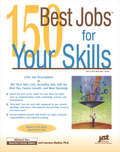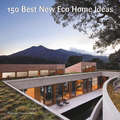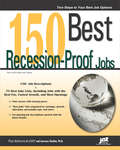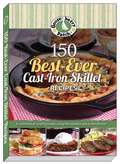- Table View
- List View
150 Activities For Bored Dogs: Surefire Ways to Keep Your Dog Active and Happy
by Sue Owens WrightIs your least favorite part of the day leaving your best friend behind? Are you tired of coming home to chewed-up sofas and shoes and garbage in places it shouldn't be? Now you can turn your bored dog into an active dog with 150 Activities for Bored Dogs.With a great mix of activities for the home-alone dog, as well as activities that let you in on the fun, 150 Activities for Bored Dogs includes chapters on Fun Fur One, Fun Fur Two, and Fun Fur the Whole Doggone Pack."Fetch" will seem like puppy play when you discover activities like:Hide the TreatsRexerciseTetherball TugFinally, you can leave puppy guilt behind, thanks to 150 Activities for Bored Dogs.
150 Activities for Bored Dogs
by Sue Owens WrightAsk dog owners anywhere, and they'll tell you their least favorite part of the day is leaving their best friend behind when they leave the house. It's safe to say they don't enjoy coming home to chewed up sofas, shoes, and garbage as well. Now, dog owners can turn their bored dog into an active dog with "150 Activities for Bored Dogs". A great mix of activities for the latch-key dog as well as activities that allow the reader to get in on the fun, "150 Activities for Bored Dogs" includes chapters on Fun Fur One, Fun Fur Two, and Fun Fur the Whole Doggone Pack. "Fetch" will seem like puppy play when readers discover activities like: Hide the Treats; Rexercise; and, Tetherball Tug. The busy dog owner can finally leave guilt behind, thanks to "150 Activities for Bored Dogs".
150 Backyard Cookout Recipes
by Gooseberry PatchMaybe it's the fresh air or the smoky aroma...but we think just about everything tastes better when it's cooked outdoors! Is your family bored with plain old burgers and hot dogs? Jazz up the buns with sizzling herb burgers and camp-out chili dogs...or how about charcoal grilled pizza instead? Show off your cookout skills with lazy-day grilled ribs, grilled flank steak sandwich and ginger-lime grilled salmon. Or cook up an easy meal-in-one like bountiful hobo packs or kiddies&’ chicken packets. To round out a delicious backyard meal, who could resist confetti corn salad, balsamic grilled tomatoes, bacon corn on the cob and smoky new potatoes? But save room for dessert, because there's grilled pineapple sundaes and melty chocolate burritos too! You'll find easy directions using familiar ingredients. So fire up the grill...let's cook out tonight!
150 Best All New House Ideas
by Francesc ZamoraFrom the highly successful 150 Best series, the ultimate resource for single home buyers and owners, architects, developers, and designers, filled with contemporary, fresh ideas for sustainable construction and gorgeous interiors, vividly captured in hundreds of stunning four-color photographs.150 Best All New House Ideas is a visually stunning look at the latest in innovative home construction and interior design. It brings together an extensive collection of single-family houses from all over the world, created by distinguished international architects and designers who have worked to achieve practical and functional solutions adapted to the specific needs and particular tastes of their clients. Each of the 150 houses profiled showcases the latest trends and up-to-date influences from around the world. The houses displayed come in all sizes, from mini cottages to multi-room manors. Taking advantage of technological advances in building and materials, all of these homes are beautiful and inviting as well as energy efficient and environmentally friendly.This beautiful compilation brings together the diversity of current trends in house design and is an inspirational source of ideas for homeowners and those considering buying, interior designers, builders, architects, lighting, textile, and furniture makers, and students.
150 Best Cottage and Cabin Ideas
by Francesc ZamoraThe latest volume in the popular 150 Best series, 150 Best Cottage & Cabin Ideas is your ultimate resource for creating the ideal remote retreat. Discover 150 cottages and cabins from around the world that feature the luxury of modern home construction while preserving the surrounding landscape and utilizing local natural resources. These enviable dwellings showcase inspirations for homeowners, designers, and architects--from exposed-beam ceilings and built-in furnishings to large open-floor plans and floor-to-ceiling windows that accentuate picturesque views of the great outdoors.Filled with stunning full-color photographs and detailed design plans, this volume highlights hidden sanctuaries that offer spacious, comfortable, and, most important, more natural living environments. Whether you're planning a vacation with family and friends or looking for a way to escape the daily grind, this book allows you to explore the diversity and simplicity of the modern cottage and cabin.
150 Best Eco House Ideas
by Marta SerratsFeaturing an extensive collection of full-color photographs, 150 Best Eco House Ideas features eco-friendly house designs created by internationally renowned architects and designers who have achieved practical, innovative, and stunning solutions adapted to the specific needs and tastes of their clients. Included here are the latest innovations in sustainable home design, including solar paneling, wind energy systems, environmentally-friendly heating and cooling solutions, thermal glazing, and trombe walls.150 Best Eco House Ideas covering the diversity of current trends in sustainable home design, and is both the perfect resource for designers, interior decorators, and architects, as well an inspirational sourcebook for all homeowners interested in creating warm and inviting homes that cause only a fraction of the environmental impact of those created using conventional building methods.
150 Best Interior Design Ideas
by NoneAn in-depth review of the latest trends in residential interior designs from internationally renowned architects and designers, showcasing 150 full-color profiles and 500 pages of color photos—an outstanding addition to the popular 150 Best series.In 150 Best Interior Design Ideas you’ll find the most attractive, functional, and cost-effective design solutions for every room in the house. Some of the top architects and designers working around the globe today experiment with arrangement, color, texture, material, and finishes to create personalized spaces to suit every aesthetic preference.Featuring full-color photographs and diagrams, this exciting entry in the highly successful 150 Best series is an inspirational source of ideas to help you create beauty in your everyday surroundings, and is an essential reference of current trends in interior design for designers, decorators, architects, and homeowners.
150 Best Jobs for Your Skills
by Michael Farr Laurence ShatkinThis ground-breaking book offers an efficient, to-the-point format that helps job seekers and students discover the best jobs for their skills in just three simple steps. A self-assessment helps readers discover their top three career skills, then matches them to 50 best jobs for each skill.
150 Best Mini Interior Ideas
by Francesc ZamoraFeaturing interiors that exemplify the beauty and simplicity of small-space design, 150 Best Mini Interior Ideas is the latest volume in the bestselling 150 Best series.Composed of stunning photographs, floor plans, and insightful text, this book will help you discover how architects and designers from around the world work within a confined square footage to create innovative living spaces. 150 Best Mini Interior Ideas profiles a diverse range of homes, from rural and urban constructions to town houses and renovations. It reveals how to utilize walls, floors, and furniture to make a small room appear large, and it shares other methods and decorating tricks to inspire homeowners and designers.Secret storage systems, convertible furniture, and mindfulness of materials combine to create unique and flexible homes. This extensive collection celebrates functional, striking design meant to maximize the most minimal of spaces.
150 Best Minimalist House Ideas
by Alex SanchezOne of the most popular interior design trends, minimalism highlights the essence of a room, stressing clean lines, clutter-free spaces, and a limited color palette.In 150 Best Minimalist House Ideas, photographs and floor plans of minimalist homes around the world are featured. The images are of stunning bedrooms, living rooms, dining rooms, kitchens, and bathrooms; and insightful text complements them to reveal the methods used to make the minimalist rooms so eye-catching and desirable. The text includes a wealth of both big-picture and more focused ideas. It covers subjects such as walls (if and when to use them), doors, and partitions; flooring, lighting, furniture, and staircases; and explores color, patterns, materials, and texture.The houses featured in this extraordinary volume were developed by distinguished international designers at the forefront of the minimalist movement. The result is a guide that offers both inspiration and practical, easy-to follow advice for creating maximum beauty using minimal elements.
150 Best New Apartment Ideas
by Francesc Zamora MolaThis information-packed volume explores the manifold ways in which architects and designers meet the various challenges of designing and decorating apartments for their clients. Featuring an extensive collection of apartments from around the world, 150 Best New Apartment Ideas provides an in-depth look at the most stunning, innovative, and practical design solutions working today. Covering a wealth of information and showcasing the latest design trends, this little book is an inspirational source of ideas, perfect for the homeowner and the professional alike.
150 Best New Bathroom Ideas
by Francesc ZamoraAn essential reference and the latest in the popular 150 Best series, 150 Best New Bathroom Ideas offers an in-depth look at modern bathroom designs created by internationally renowned architects and designers.Inside, readers will discover harmonious approaches and practical materials to use when designing bathrooms, from light fixtures and color schemes to floor, wall, and window treatments. Along with numerous ideas for the shower, toilet, sink, and bathtub, this book is an indispensable guide to designing an attractive, functional, and cost-effective bathroom.Featuring hundreds of photographs, 150 Best New Bathroom Ideas explores the diversity of current trends and is an excellent source of ideas for homeowners, designers, interior decorators, and architects. From the glamorous and roomy bath-spa to the small but smart powder room, bathrooms can make a big statement with creative ideas that are as stylish as they are useful.
150 Best New Cottage and Cabin Ideas
by Francesc ZamoraCreate a cozy getaway with this fabulous compendium in the highly successful 150 Best series, packed with images, ideas, inspiration, and information on the latest trends in small space design.150 Best New Cottage and Cabin Ideas shows off a diversity of creative, and innovative getaway homes the exemplify the small-space trend. Francesc Zamora draws on the developments of distinguished international architects and designers who have worked to achieve practical, innovative, and stylish solutions adapted to the specific needs and particular tastes of their clients.Filled with hundreds of color and black-and-white photographs, this comprehensive handbook offers an extensive collection of cabins and cottages from all over the world, and provides an inspirational source of ideas for architects, designers, and homeowners alike—whether you’re looking to design and build a new dwelling or renovating and redecorating an existing structure.
150 Best New Eco Home Ideas
by NoneDiscover the latest in sustainable architecture and environmentally friendly home design in this outstanding volume in the popular 150 Best series, which features nearly 500 pages of full-color photographs and dozens of inventive and decorative profiles.Architects, designers, and homeowners today looking for comfortable, beautiful dwellings with a minimal carbon footprint will find a cornucopia of ideas in this handsome compendium. A fabulous review of the most forward-thinking eco-friendly house designs being created today, 150 Best New Eco Home Ideas showcases the work of internationally renowned architects and designers who have achieved practical, innovative, and stunning solutions around the globe.From solar paneling and wind energy systems to environmentally-friendly heating and cooling solutions and thermal glazing to trombe walls, 150 Best New Eco Home Ideas covers the latest trends and breakthroughs in eco homes. Inspiring and inventive, this lush sourcebook is essential for architects, designers, interior decorators, and all conscientious homeowners interested in creating warm and inviting homes with only a fraction of the environmental impact of those using conventional methods.
150 Best New Interior Design Ideas
by Macarena Abascal ValdenebroKeep current with the latest trends in interior design today with this informative and inspiring guide in the 150 Best series, packed with 500 pages of color and black-and-white photography.Discover how internationally renowned architects and designers are revitalizing modern design in this must-have compendium showcasing 150 full-color living spaces. In 150 Best New Interior Design Ideas, Macarena Abascal Valdenebro curates the most attractive, functional, and one-of-a-kind design ideas for a diverse range of living spaces. Renowned architects and designers from around the globe experiment with arrangement, color, texture, material, and finishes to create personalized spaces to suit every aesthetic preference.With full-color photographs, diagrams, and detailed descriptions, this exciting volume in the 150 Best series is a fount of ideas that will inspire students, young professionals, and seasoned pros alike to create beauty in everyday surroundings. A gorgeous, up-to-date chronicle of current design trends, 150 Best New Interior Design Ideas is an essential reference for designers, decorators, architects, and homeowners.
150 Best New Kitchen Ideas
by Manel Gutierrez150 Best New Kitchen Ideas offers interior designers and homeowners the latest in modern and traditional kitchen design. Showcasing 150 profiles of the most exciting kitchen designs from around the world, this stunning compendium provides innovative solutions and practical advice for creating attractive, functional, and affordable kitchens, no matter the size of the space. Explore the diversity of current trends from concept design to beautiful finished kitchens--there is no shortage of ideas or wares to make cooking a much more pleasant experience. The newest addition to the 150 Best series, this indispensable guide, illustrated with hundreds of photographs, is an inspirational source of original ideas to create a beautiful new kitchen.
150 Best Recession-Proof Jobs
by Laurence Shatkin Editors at JISTThe detailed job descriptions give helpful facts on pay, growth, openings, tasks, skills needed, education and training required, work environment, job security, highest- and lowest-growth industries for the job, and fastest-growing metropolitan areas for the job.
150 Best Sustainable House Ideas
by Francesc Zamora150 Best Sustainable House Ideas features the latest innovations in environmentally friendly home design. From heating and cooling solutions to wind energy systems, solar paneling, thermal glazing, and even Trombe walls, the ideas featured inside are complemented by photographs and architectural plans of gorgeous, sustainable houses around the world.
150 Best Terrace and Balcony Ideas
by Irene Alegre150 Best Terrace and Balcony Ideas is the ultimate resource for innovative terrace, roof garden, patio, and balcony design ideas for outdoor spaces of all shapes and sizes. Featured inside this lavish guidebook are 150 never-before-shared tips and techniques provided by internationally renowned architects and designers, along with full-color photographs and diagrams of sixty-five uniquely beautiful projects from around the world. The design ideas reveal how to create exterior spaces that are clean, modern, and comfortable, as well as how to use cutting-edge materials that are practical, cost-effective, and environmentally friendly. Best of all, the design ideas featured inside are easy to follow and can be tailored to the unique tastes and needs of individual homeowners.
150 Best Tiny Home Ideas
by Manel Gutiérrez CoutoThe latest volume in the 150 Best series, 150 Best Tiny Home Ideas showcases a wide selection of urban and rural homes from around the world that exemplify tiny home living. Filled with detailed, full-color photographs, comprehensive layout illustrations, and informative descriptions, this useful guidebook responds to the space limitations of contemporary environments and highlights the newest innovations in efficient and successful small-space design. In recent years, tiny homes have not only become hugely popular because of their creative use of space but also necessary to deal with increasingly crowded living conditions. In this lush volume, you'll discover the most current and effective trends in tiny home design that work to enhance the comfort and practicality of the home without sacrificing the design. Featuring 150 homes designed by world-renowned architects and designers, 150 Best Tiny Home Ideas is the must-have resource for those interested in the construction and design of small-space living.
150 Best Tiny Interior Ideas
by Francesc ZamoraFrom the 150 Best series, a gorgeous collection of inspiring design ideas for transforming tiny interiors into beautiful and inviting living spaces.Over the past decade, tiny spaces have grown in popularity thanks to skyrocketing real estate costs, increased awareness of climate change, and a return to urban living. But a smaller living space doesn’t mean sacrificing sophistication or comfort. 150 Best Tiny Interior Ideas showcases the latest ideas of internationally renowned architects and designers who have devised beautiful, practical, and eco-friendly solutions adapted to the specific needs and tastes of their clients.All of the projects featured in 150 Best Tiny Interior Ideas are under 1,100 square feet and show off the latest innovations in small space design from around the world. Discover how to live practically and beautifully in a 3D-printed concrete cabin in Ithaca, New York, a 240 square-foot aux box in Parksville, British Columbia, or a flat with a flexible layout in Hong Kong. Packed with hundreds of full-color photographs, and covering current trends, 150 Best Tiny Interior Ideas is an essential resource for designers, interior decorators, architects, and students, as well as an inspirational sourcebook for homeowners and apartment dwellers interested in downsizing or who’ve made the move, offering ideas for maximizing space while creating warm and inviting homes.
150 Best of the Best Apartment Ideas
by Francesc ZamoraThis gorgeous full-color guide in the popular design series showcases 150 apartments that demonstrate the range and imagination of some of the world’s top architects and interior designers working today.Homeowners, designers, and architects are always looking for new sources of inspiration. 150 Best of the Best Apartment Ideas offers hundreds of photos of some of the most innovative and interesting apartments from around the world. Each of the entries have been created by distinguished international architects and designers who have worked to achieve practical, innovative, and stunning solutions adapted to the specific needs and particular tastes of their clients—using eco-friendly and sustainable materials. Expressing the diversity of current trends in apartment design 150 Best of the Best Apartments is an invaluable resource for professionals and students in various fields, including architecture, interior design, and retail, as well as homeowners looking to keep current on the latest in contemporary residential architecture.
150 Best of the Best House Ideas
by Francesc ZamoraPacked with hundreds of pages of beautiful and inspirational color photographs of homes from around the world, a visually stunning resource and guide--part of the successful 150 Best series--featuring the latest in modern home construction and design.A comprehensive collection of single-family houses created by some of the most distinguished international architects and designers, 150 Best of the Best House Ideas showcase the latest trends and various influences on home design. Incorporating the most up-to-date technological advances in construction and material use, these beautiful dwellings, from cottage-style designs to minimalist geometric constructions, are visually appealing, energy-efficient, and have a low environmental impact. This beautiful compilation expresses the diversity of current building trends and provides an inspirational source of ideas for artists, designers, architects, home buyers and owners, and anyone interested in keeping-up-to-date with contemporary residential architecture.
150 Best of the Best Loft Ideas
by Inc. Loft PublicationsFilled with beautiful full-color photographs and detailed illustrations, an irresistible collection profiling 150 of the latest trends in contemporary loft design.The ultimate resource for designing and decorating loft spaces, 150 Best of the Best Loft Ideas presents 150 stunning lofts constructed and designed by notable architects and designers from around the world. Made popular in the nineteen fifties and sixties in New York City, lofts--synonymous with a modern, avant-garde lifestyle--continue to maintain their wide appeal. While loft living once meant converting old industrial warehouses into a warm and inviting living environment, today the style has evolved into an airy, open approach for any modern living space.This compilation highlights the diversity of current trends in loft design and is a source of creative inspiration for architects, designers, and home owners interested in staying current with the latest in contemporary residential architecture.
150 Best-Ever Cast Iron Skillet Recipes
by Gooseberry PatchBest known for their collection of family-friendly, community-style cookbooks. Each Gooseberry Patch cookbook is created with today's time-strapped, budget-conscious families in mind and filled with recipes shared by cooks all across the country. Along with treasured family recipes, each book includes the stories the go along with these tried & true dishes.With more than 220 titles and over 9 million copies in print, plus an ever-growing collection of eBooks, Gooseberry Patch has grown from a kitchen-table operation to a nationally recognized best-selling published brand. "I always buy a Gooseberry Patch cookbook for bridal showers. New cooks and seasoned pros alike can find something to please their families on the pages of Gooseberry Patch!" ~ Wendy from Waynesville, NC























